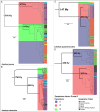Comparative phylogeography uncovers evolutionary past of Holarctic dragonflies
- PMID: 34221703
- PMCID: PMC8236228
- DOI: 10.7717/peerj.11338
Comparative phylogeography uncovers evolutionary past of Holarctic dragonflies
Abstract
Here, we investigate the evolutionary history of five northern dragonfly species to evaluate what role the last glaciation period may have played in their current distributions. We look at the population structure and estimate divergence times for populations of the following species: Aeshna juncea (Linnaeus), Aeshna subarctica Walker, Sympetrum danae (Sulzer), Libellula quadrimaculata Linnaeus and Somatochlora sahlbergi Trybom across their Holarctic range. Our results suggest a common phylogeographic pattern across all species except for S. sahlbergi. First, we find that North American and European populations are genetically distinct and have perhaps been separated for more than 400,000 years. Second, our data suggests that, based on genetics, populations from the Greater Beringian region (Beringia, Japan and China) have haplotypes that cluster with North America or Europe depending on the species rather than having a shared geographic affinity. This is perhaps a result of fluctuating sea levels and ice sheet coverage during the Quaternary period that influenced dispersal routes and refugia. Indeed, glacial Beringia may have been as much a transit zone as a refugia for dragonflies. Somatochlora sahlbergi shows no genetic variation across its range and therefore does not share the geographic patterns found in the other circumboreal dragonflies studied here. Lastly, we discuss the taxonomic status of Sympetrum danae, which our results indicate is a species complex comprising two species, one found in Eurasia through Beringia, and the other in North America east and south of Beringia. Through this study we present a shared history among different species from different families of dragonflies, which are influenced by the climatic fluctuations of the past.
Keywords: Aeshna; Beringia; Circumboreal; Dragonflies; Holarctic; Libellula; Phylogeography; Somatochlora; Sympetrum.
© 2021 Kohli et al.
Conflict of interest statement
The authors declare that they have no competing interests.
Figures



References
-
- Artiss T. Phylogeography of a facultatively migratory dragonfly, Libellulaquadrimaculata (Odonata: Anisoptera) Hydrobiologia. 2004;515(1–3):225–234. doi: 10.1023/B:HYDR.0000027332.57786.9d. - DOI
-
- Assmann T, Nolte O, Reuter H. Carabid Beetles: Ecology and Evolution. Berlin: Springer; 1994. Postglacial colonization of middle Europe by Carabus auronitens as revealed by population genetics (Coleoptera, Carabidae.
-
- Bernard Rł, Heiser M, Hochkirch A, Schmitt T. Genetic homogeneity of the Sedgling Nehalennia speciosa (Odonata: Coenagrionidae) indicates a single Würm glacial refugium and trans-Palaearctic postglacial expansion. Journal of Zoological Systematics and Evolutionary Research. 2011;49(4):292–297. doi: 10.1111/j.1439-0469.2011.00630.x. - DOI
-
- Bidegaray-Batista L, Sánchez-gracia A, Santulli G, Maiorano L, Guisan A, Vogler AP, Arnedo MA. Imprints of multiple glacial refugia in the Pyrenees revealed by phylogeography and palaeodistribution modelling of an endemic spider. Molecular Ecology. 2016;25(9):2046–2064. doi: 10.1111/mec.13585. - DOI - PubMed
LinkOut - more resources
Full Text Sources
Miscellaneous

